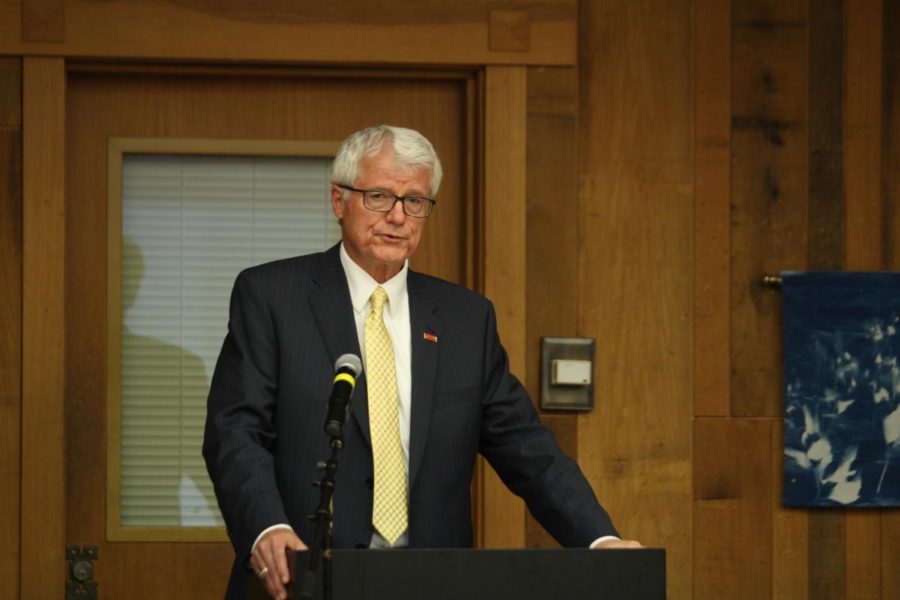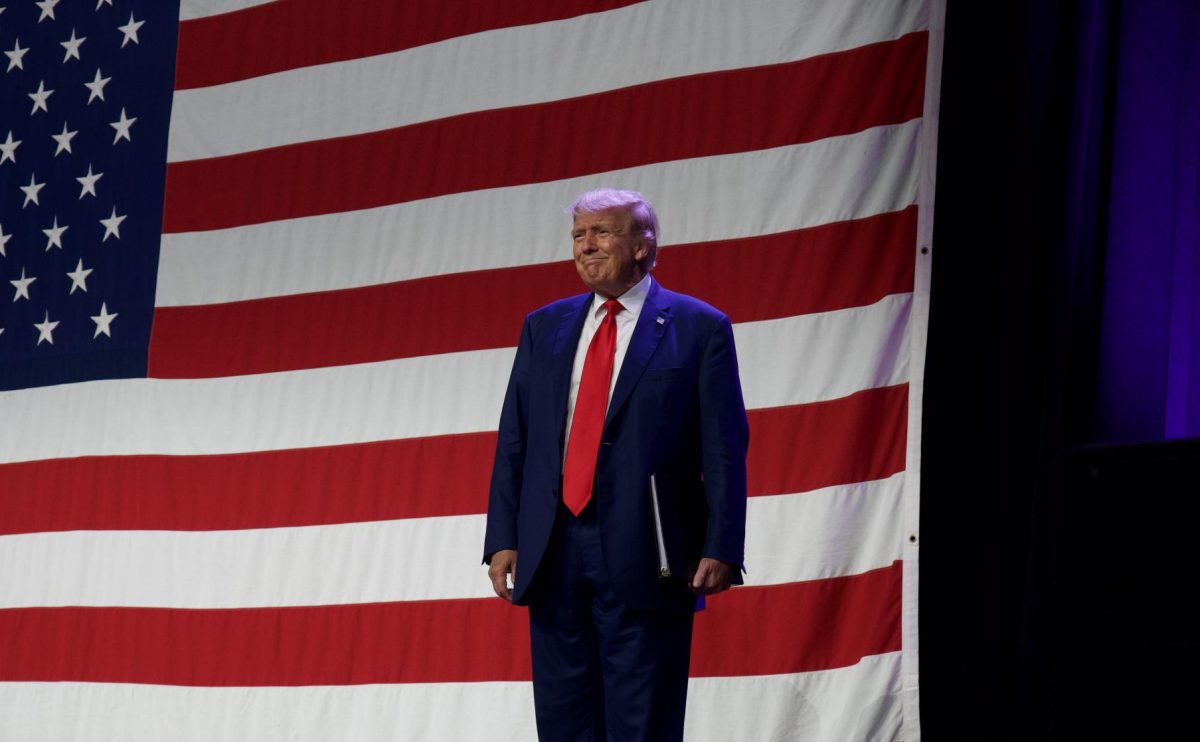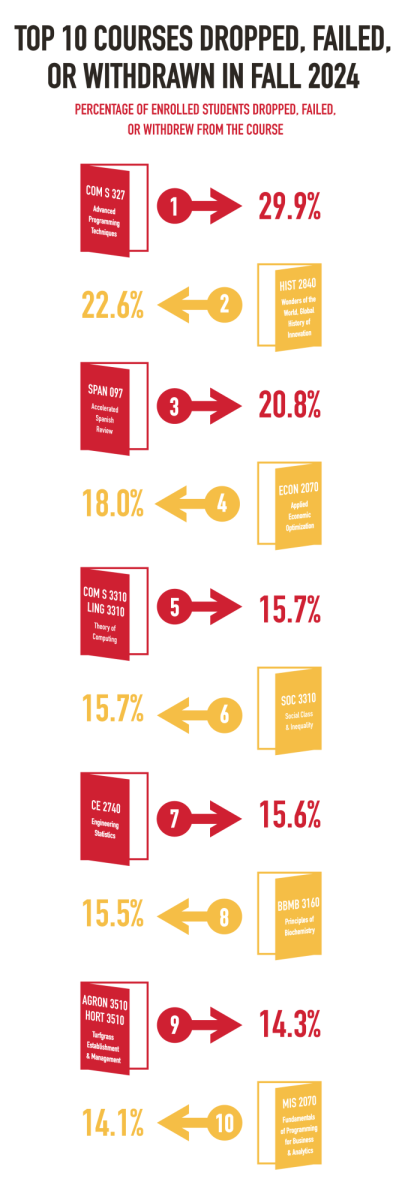- News
- News / Academics
- News / Politics And Administration
- News / Politics And Administration / Campus
- News / Politics And Administration / City
How Iowa State colleges implement differing tuition costs
February 19, 2018
There has been considerable uncertainty about state funding, as well as a promise to only increase tuition once this academic year.
It is for these reasons, Iowa students at all three regent universities will not know what their tuition costs will look like for next year until April, with approval of the increase not until June — two months before students return to school.
However, years of lagging state appropriations and tuition increases are not uncommon. As far as higher education funding goes, it may be one of the only things Iowa students can expect come each year when the statehouse revisits Iowa’s budget.
“Unfortunately, there are very few things that are predictable in today’s world.” Iowa State President Wendy Wintersteen said in an interview in early February. “So as we look at the work the legislature, as we look at the economic struggles of the state and what that might mean in terms of cuts to the Board of Regents, I think that makes predictability difficult.”
So, how to understand Iowa’s tuition climate? It’s not easy.
In early August, interim Iowa State President Benjamin Allen was tasked with presenting a tuition proposal to the Iowa Board of Regents tuition task force. The task force convened after two rounds of state funding cuts that totaled more than $30 million.
The proposal presented by Iowa State was simple: It focused on what it would take to fund the resources to maintain, as well as grow, the quality of its education.
This could be done through meeting certain goals including to recruit and hire 330 new faculty and staff, to meet deferred maintenance needs and to grow the university 900,000 square feet so resources can serve at capacity.
To get to this point? A five-year annual 7 percent increase for resident undergraduates and a 4 percent increase for non-resident undergraduates. Additionally, Iowa State proposed differential adjustments for engineering, business and other STEM programs.
Students did not take this proposal lightly. At the time, Student Government President Cody West and Vice President Cody Smith said in a joint statement: “The time has come that we move past pointing fingers at the university administration and the Iowa Board of Regents and demand that our state legislators make higher education a priority again in Iowa.”
History of tuition
In October 1999, the Board of Regents approved a 4.3 percent across-the-board increase in tuition. The Regents proposal, as outlined in budget documents dating back to 2001, was to use tuition revenues to “cover the salary shortfall” due to reduced state appropriations.
Their mantra? Maintenance of quality rather than improvement of quality.
At this point in time, state appropriations made up nearly twice as much of the revenue going toward the university, $200 million, to what tuition and fees, $100 million, were contributing.
By 2002, however, a phrase began to grow familiar in the annual budget report provided by the regents on university funding: “The budget process presented challenges for the regent institutions.”
With base state appropriations lagging, $42.1 million less than the previous year, regents had to prioritize revenue and expenditures, as well as where to get the money to begin with.
Reductions in state appropriations at another drastic level hit the Board of Regents again in 2003 with state appropriations being reduced by $42.6 million between fiscal years and additional reductions by the legislature in 2002 of $81.9 million.
To combat this, student tuition and fees began to transition in its role of funding the university. Preemptively, in November 2001 the board approved an 18.5 percent increase in base tuition for regent universities.
In 2004, the trend of lagging state appropriations seemed to be continuous and almost a certainty. A 17.6 percent increase in undergraduate resident base tuition was instilled for the year, but it still wasn’t quite enough.
So a concern developed — even with the increased tuition, the university could still not cover the state cuts or meet the mandatory state salary increases.
As the years passed the Regents responded to a similar tune: State appropriations down. Tuition up.
By 2012, with continued enrollment and university growth but lagging state support, the board crunched the numbers: “State operating support for higher education has been reduced 24 percent since the beginning of FY 2009 and is now less than funding levels received in FY 1997.”
Recognizing the continued financial burden the regents and state legislature were placing on students through ongoing tuition increases, then-Board of Regents President Bruce Rastetter and the board approved a tuition freeze for undergraduates that lasted from 2013 to 2015.
What now?
On Friday evening, Student Government released a petition asking the state to “invest in us” and that “enough is enough.”
“As an institution, we have reached a critical juncture where we face harsh realities if these drastic cuts happen. This egregious disinvestment could result in faculty furloughs, cancelled classes and discontinued student aid,” the petition reads.
Currently, Reynolds is recommending a midyear reduction of $5.1 million to Iowa Board of Regents budget. The House and Senate, who shape the legislation that ultimately decides the budget, is proposing a $8.1 million and $14.1 million reduction, respectively.
Provost Jonathan Wickert said during a Faculty Senate meeting last week that if these cuts are enacted “draconian steps” will be taken.
“With the last two years seeing $11.5 million in cuts to Iowa State’s budget, these budget changes will cut to the bone,” Wickert said. “The possible implications of these cuts for Iowa State include faculty furloughs, cancelled classes and discontinued student aid.”
Wintersteen touched on previous implications lagging state appropriations have had on Iowa State during her interview with the Daily, specifically its impact on the university through faculty retention.
“I think it’s important to understand that the university exists in a competitive environment and that our faculty and staff do not have to work here and that if we don’t provide the right environment and certainly salary is a part of having the right environment,” she said.
In June 2017, Allen announced that due to last year’s midyear cuts, there will not be mandatory university salary increases for the upcoming fiscal year.
For many years, in line with lagging state appropriations, Iowa State was at the bottom of its peer group in salary to faculty and staff. Only recently has Iowa State increased its ranking, according to regent documents.
“So, if we can’t compete then we won’t have the best faculty and staff here,” Wintersteen said.
The role of differential tuition in this process
With the understanding that more and more revenue to the regent universities must come from tuition, Iowa State has looked to different tuition models including those that are performance-based, dependent on year or major.
In 2014, the regents considered an appropriation model called performance-based funding which allocates a portion of the state’s higher education budget based on its performance measures.
If enacted, Iowa State would have been awarded the most funding because of the amount of in-state students enrolled here. Essentially, it was an effort to “award Iowa taxpayers who pay taxes for the regent universities.”
The model would have also taken into consideration factors such as: student progress, access for low-income and minority students, sponsored research, and graduate and professional students.
The legislature decided against implementing the model despite the regents recommendation and some university support.
Enter differential tuition, which in some colleges such as engineering and business, has existed for years.
Differential tuition is a model that takes into consideration one’s major and how it may cost more to fund an individual’s education through additional lab equipment or the retention of top-tier faculty.
As the years have passed, nearly every college at Iowa State has implemented the model in some shape or form.
“Over the past year, several colleges have been having conversations with students about proposals to look at an increase in a number of majors that would be included in the differential tuition process,” Wintersteen said. “That is now in a process of being taken forward and looked at by the Board of Regents.”
For students such as Edan Lambert, senior in animal science and previous College of Agriculture and Life Sciences, CALS, Student Council president, differential tuition makes sense.
In reference to last year, Lambert said then-Dean Wintersteen went to the CALS Student Council several times to discuss tuition. He said she also went to every department club that might also be impacted by it.
“She helped us all understand that in order to keep our education at the top of its level and be one of the top ranking agricultural schools in the world, this was what needed to be done,” she said.
So, what does it look like within each college?
Where it’s been
With state budget cuts and increases in tuition, students are looking for ways to lower tuition costs in any way possible.
The College of Business and College of Engineering took student polls and worked with student council to figure out the best way to go about differential tuition.
The whole planning process took about two years.
Differential tuition has been a part of the College of Business since 2012.
The Ivy College of Business is the second newest college at Iowa State, behind the College of Human Sciences, and the second largest in terms of enrollment.
David Spalding, the dean of the College of Business said differential tuition is necessary in a college where the enrollment has been so large in such a short amount of time.
Spalding said almost all of the money differential tuition raises goes toward hiring new, more valuable faculty. The main goal differential tuition funds is lowering the student-faculty ratio.
Spalding also said differential tuition will in part offset cost of loans for a new business building, but most of the building itself is funded by donations, grants and loans.
The College of Engineering was the first college at Iowa State to adopt differential tuition in 2006.
Dean of Engineering Sara Rajala explained how the College of Engineering uses differential tuition slightly differently than the College of Business.
Most, about 70 percent, of differential tuition is used for hiring and training faculty, while the rest is split between improving lab equipment and student spaces.
In the department of agriculture and biosystems engineering, the student lounge in the basement was funded mostly by differential tuition, as well as many labs and equipment in the building labeled by red signs which read “Lab Equipment Supported In Part By Differential Tuition”.
Steve Mickelson, department of agriculture and biosystems engineering chair, said there is no exact number of dollars these labs, student spaces or faculty salaries are funded by.
Just like business, much of the same things differential tuition goes toward is also funded by donations and grants.
— Christian Simmons
Where it’s new
Ava Schroedl, senior in biological/pre-medical illustration, said the main student opinion of differential tuition from students in her program is: Where did this come from and why is it happening?
For many students, lagging the broader history of higher education funding in Iowa is not uncommon. With many students staying for just four short years, sometimes five, it’s hard to comprehend the fluctuating costs of public university.
But that doesn’t mean it’s not surprising when one learns they are paying an upward of $800 more for their education than others in the college because of the program.
In 2011, just two College of Agriculture and Life Sciences majors paid differential tuition.
By 2017, that number has expanded to eight to now include — animal ecology, animal science, agricultural systems technology, biology, dairy science, forestry, pre-veterinary medicine, genetics, industrial technology and microbiology.
But for the College of Liberal Arts and Sciences, this is the first academic year any major is being impacted by differential tuition — biological/pre-medical illustration, computer science, biology and genetics.
In both of the colleges, differential tuition is being phased in over a span of three years. This academic year, junior and senior level students will be paying $267 more than the undergraduate base tuition each semester. This number expands to $533 in the 2018 academic year and $800 in 2019.
“I hope this helps students and parents to plan ahead,” said Donald Beermann, animal science department chair. “That was the whole intent in having phased in approach.”
Differential tuition will affect junior and senior level students after 60 credit hours have been reached. At those higher levels, Dean of the College of Liberal Arts and Sciences Beate Schmittmann said the cost of instruction is greater, faculty and student relationships tend to be closer and students take a lot more lab and interactive courses.
Specifically deciding where this money goes is a partnership between the administration, faculty and students.
“That’s a model that engineering uses, that business uses,” Schmittmann said. “So the students have some understanding of how much additional revenue is coming in … and how much can be a new investment.”
There has already been a current and planned usage for the differential tuition money in a multitude of programs. In animal science, they have used the uptick in funding toward hiring much needed faculty members and upgrading teaching facilities.
“These are the kind of things that are really getting us up to where we should be,” Beermann said. “You can’t do it with outdated equipment and facilities.”
Joe Colletti, interim dean of the College of Agriculture and Life Sciences, seconded the importance that differential tuition plays in the interactive side of learning.
“The hands-on experience learning aspect is really what’s enhanced by the differential tuition,” Colletti said.
“We do want to reinvest in them and make sure the upper level students who are paying it actually get what they really want and need of it,” said Lynn Clark, director of the biological/pre-medical illustration program.
Looking ahead, Schroedl, said her concerns are about where the money goes.
“Just that the money stays within the program, also that students are still able to participate no matter what their family background is,” said Schroedl.
— Annelise Wells
Where it’s expanding
For the College of Human Sciences and the College of Design, the model recognized as differential tuition has yet to phase itself into the programs fees.
Currently, there are just two programs at the College of Design who partake in differential tuition: architecture and industrial design. A proposal to include all of the other design programs, except visual cultural studies, is in the works.
College of Human Sciences (CHS) currently has no differential tuition placed on the base tuition for students, but that may be changing soon. A proposal made by CHS will be presented at the next Iowa Board of Regents meeting. A proposed price for differential tuition at the College of Design is non-existent at the moment.
For students in architecture, their undergraduate base tuition is $703 more per semester than their other design peers. For industrial design undergraduates, their base tuition is $267 more per semester. This is not the full amount, however, as it is currently in a three-year phase in.
Students begin paying differential tuition once they are admitted into the professional program. Should differential tuition be implemented into other programs, a similar process is expected.
“We want to be transparent about differential tuition and make sure to minimize the impact for students and parents as much as possible,” said Luis Rico-Gutierrez, dean of the College of Design. “It is important we make everyone aware of where their tuition dollars are going.”
College of Human Sciences Dean Laura Jolly said she does not have the information on how much the tuition for students would increase if the proposal is passed.
Rico-Gutierrez said the two driving factors for differential tuition are smaller teacher-to-student ratios and space. Tuition dollars go toward necessary studio space, Rico-Gutierrez said, as design students use their space more intensely. Teacher-to-student ratio needs to remain small, as well, in order to properly provide constructive feedback.
For the College of Human Sciences, its need for differential tuition can be broken down too, as a tangible need with one of the biggest reasons being the growth the college has seen over the last several years.
For example, Philip Martin, kinesiology chair, said the number of kinesiology undergraduates was roughly 700 in 2005. In the fall of 2017, that number nearly doubled with 1,200 undergraduates enrolled in the program. But the growth didn’t just happen in kinesiology.
Between 2005 and 2014, the entire college’s enrollment grew by 52 percent.
So what would differential tuition look like in the College of Human Sciences? There could be more faculty, better equipment, more learning spaces, and advising and career services. These are just a few of the ideas noted by Jolly and Martin.
“We want to do everything we can to enhance students’ experiences,” Jolly said.
The College of Design aspires to a similar mantra. Rico-Gutierrez said the faculty works hard to be as innovative and creative as possible to accommodate reduction of cost to deliver the highest quality of education. The college aims to use every other opportunity of utilizing resources.
With state appropriations lagging and midyear cuts becoming a common trend, opportunities for growth and improvement are not always possible working under the current model.
“However, there is a point where if we don’t have enough resources to invest in the quality of education, then the quality of education begins to suffer,” Rico-Gutierrez said.
With maintaining successful education, the university also strives to be transparent.
Rico-Gutierrez himself has gone around the design building stopping students to discuss differential tuition with them.
“I’ve talked to students about their thoughts on differential tuition and why we’re doing it,” Rico-Gutierrez said. “I put data points in front of them and we have hosted informational meetings.”
Jolly has also met with College of Human Sciences student organizations to discuss the possibility of differential tuition.
— Kiana Brincks and Tara Larson
Clarification: In Dean David Spalding’s interview, he is indirectly quoted as saying that money from differential tuition “goes toward hiring new, more valuable faculty.” Spalding meant that the money is focused towards improving student-to-faculty ratio.
Reporting contributed by: Alex Connor, Annelise Wells, Christian Simmons, Kiana Brincks, Tara Larson







